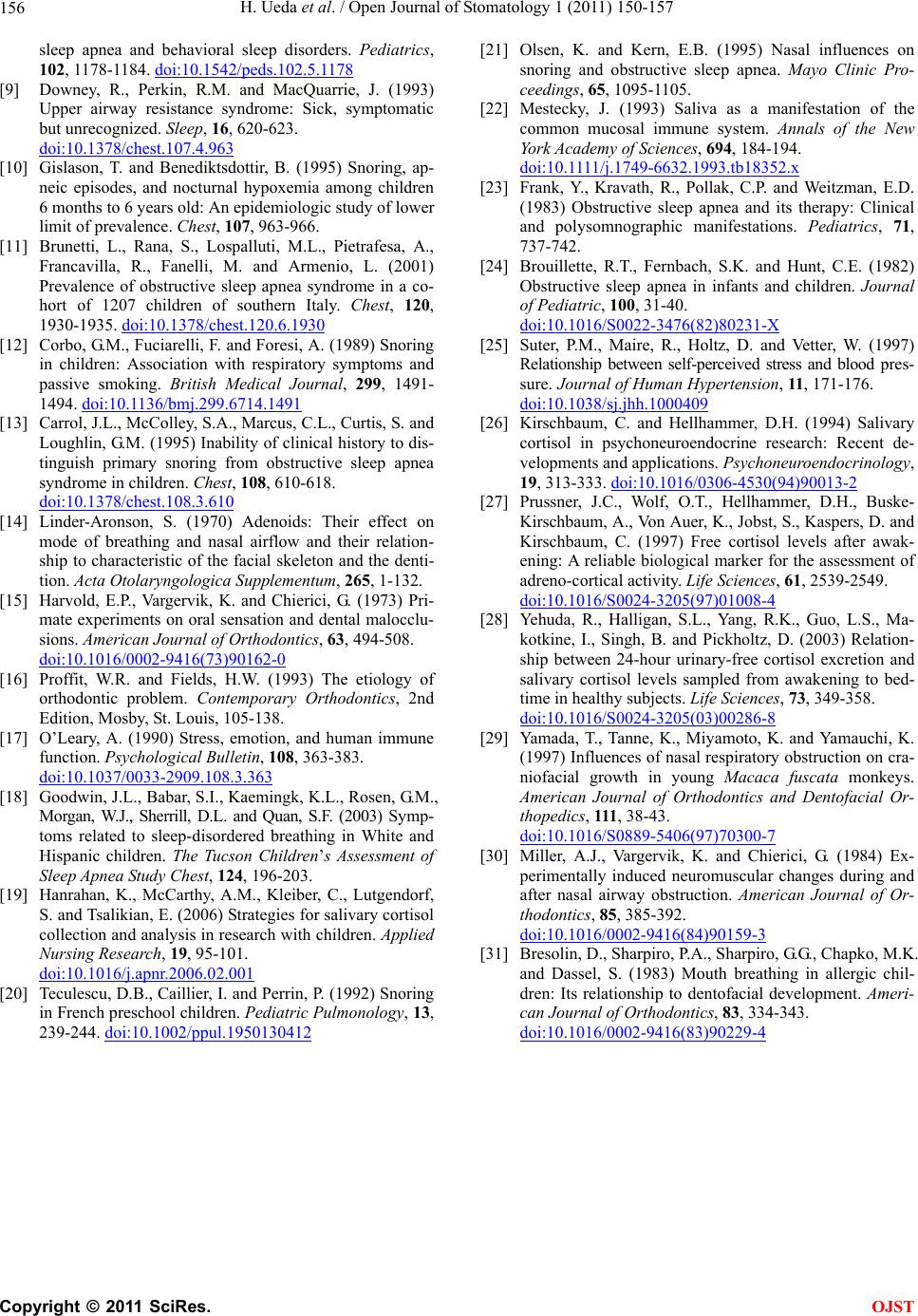
H. Ueda et al. / Open Journal of Stomatology 1 (2011) 150-157
Copyright © 2011 SciRes.
156
OJST
sleep apnea and behavioral sleep disorders. Pediatrics,
102, 1178-1184. doi:10.1542/peds.102.5.1178
[9] Downey, R., Perkin, R.M. and MacQuarrie, J. (1993)
Upper airway resistance syndrome: Sick, symptomatic
but unrecognized. Sleep, 16, 620-623.
doi:10.1378/chest.107.4.963
[10] Gislason, T. and Benediktsdottir, B. (1995) Snoring, ap-
neic episodes, and nocturnal hypoxemia among children
6 months to 6 years old: An epidemiologic study of lower
limit of prevalence. Chest, 107, 963-966.
[11] Brunetti, L., Rana, S., Lospalluti, M.L., Pietrafesa, A.,
Francavilla, R., Fanelli, M. and Armenio, L. (2001)
Prevalence of obstructive sleep apnea syndrome in a co-
hort of 1207 children of southern Italy. Chest, 120,
1930-1935. doi:10.1378/chest.120.6.1930
[12] Corbo, G.M., Fuciarelli, F. and Foresi, A. (1989) Snoring
in children: Association with respiratory symptoms and
passive smoking. British Medical Journal, 299, 1491-
1494. doi:10.1136/bmj.299.6714.1491
[13] Carrol, J.L., McColley, S.A., Marcus, C.L., Curtis, S. and
Loughlin, G.M. (1995) Inability of clinical history to dis-
tinguish primary snoring from obstructive sleep apnea
syndrome in children. Chest, 108, 610-618.
doi:10.1378/chest.108.3.610
[14] Linder-Aronson, S. (1970) Adenoids: Their effect on
mode of breathing and nasal airflow and their relation-
ship to characteristic of the facial skeleton and the denti-
tion. Acta Otolaryngologica Supplementum, 265, 1-132.
[15] Harvold, E.P., Vargervik, K. and Chierici, G. (1973) Pri-
mate experiments on oral sensation and dental malocclu-
sions. American Journal of Orthodontics, 63, 494-508.
doi:10.1016/0002-9416(73)90162-0
[16] Proffit, W.R. and Fields, H.W. (1993) The etiology of
orthodontic problem. Contemporary Orthodontics, 2nd
Edition, Mosby, St. Louis, 105-138.
[17] O’Leary, A. (1990) Stress, emotion, and human immune
function. Psychological Bulletin, 108, 363-383.
doi:10.1037/0033-2909.108.3.363
[18] Goodwin, J.L., Babar, S.I., Kaemingk, K.L., Rosen, G.M.,
Morgan, W.J., Sherrill, D.L. and Quan, S.F. (2003) Symp-
toms related to sleep-disordered breathing in White and
Hispanic children. The Tucson Children’s Assessment of
Sleep Apnea Study Chest, 124, 196-203.
[19] Hanrahan, K., McCarthy, A.M., Kleiber, C., Lutgendorf,
S. and Tsalikian, E. (2006) Strategies for salivary cortisol
collection and analysis in research with children. Applied
Nursing Research, 19, 95-101.
doi:10.1016/j.apnr.2006.02.001
[20] Teculescu, D.B., Caillier, I. and Perrin, P. (1992) Snoring
in French preschool children. Pediatric Pulmonology, 13,
239-244. doi:10.1002/ppul.1950130412
[21] Olsen, K. and Kern, E.B. (1995) Nasal influences on
snoring and obstructive sleep apnea. Mayo Clinic Pro-
ceedings, 65, 1095-1105.
[22] Mestecky, J. (1993) Saliva as a manifestation of the
common mucosal immune system. Annals of the New
York Academy of Sciences, 694, 184-194.
doi:10.1111/j.1749-6632.1993.tb18352.x
[23] Frank, Y., Kravath, R., Pollak, C.P. and Weitzman, E.D.
(1983) Obstructive sleep apnea and its therapy: Clinical
and polysomnographic manifestations. Pediatrics, 71,
737-742.
[24] Brouillette, R.T., Fernbach, S.K. and Hunt, C.E. (1982)
Obstructive sleep apnea in infants and children. Journal
of Pediatric, 100, 31-40.
doi:10.1016/S0022-3476(82)80231-X
[25] Suter, P.M., Maire, R., Holtz, D. and Vetter, W. (1997)
Relationship between self-perceived stress and blood pres-
sure. Journal of Human Hypertension, 11, 171-176.
doi:10.1038/sj.jhh.1000409
[26] Kirschbaum, C. and Hellhammer, D.H. (1994) Salivary
cortisol in psychoneuroendocrine research: Recent de-
velopments and applications. Psychoneuroendocrinology,
19, 313-333. doi:10.1016/0306-4530(94)90013-2
[27] Prussner, J.C., Wolf, O.T., Hellhammer, D.H., Buske-
Kirschbaum, A., Von Auer, K., Jobst, S., Kaspers, D. and
Kirschbaum, C. (1997) Free cortisol levels after awak-
ening: A reliable biological marker for the assessment of
adreno-cortical activity. Life Sciences, 61, 2539-2549.
doi:10.1016/S0024-3205(97)01008-4
[28] Yehuda, R., Halligan, S.L., Yang, R.K., Guo, L.S., Ma-
kotkine, I., Singh, B. and Pickholtz, D. (2003) Relation-
ship between 24-hour urinary-free cortisol excretion and
salivary cortisol levels sampled from awakening to bed-
time in healthy subjects. Life Sciences, 73, 349-358.
doi:10.1016/S0024-3205(03)00286-8
[29] Yamada, T., Tanne, K., Miyamoto, K. and Yamauchi, K.
(1997) Influences of nasal respiratory obstruction on cra-
niofacial growth in young Macaca fuscata monkeys.
American Journal of Orthodontics and Dentofacial Or-
thopedics, 111, 38-43.
doi:10.1016/S0889-5406(97)70300-7
[30] Miller, A.J., Vargervik, K. and Chierici, G. (1984) Ex-
perimentally induced neuromuscular changes during and
after nasal airway obstruction. American Journal of Or-
thodontics, 85, 385-392.
doi:10.1016/0002-9416(84)90159-3
[31] Bresolin, D., Sharpiro, P.A., Sharpiro, G.G., Chapko, M.K.
and Dassel, S. (1983) Mouth breathing in allergic chil-
dren: Its relationship to dentofacial development. Ameri-
can Journal of Orthodontics, 83, 334-343.
doi:10.1016/0002-9416(83)90229-4